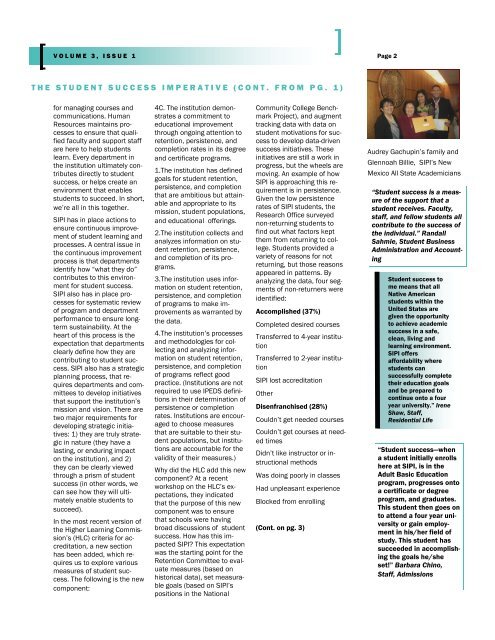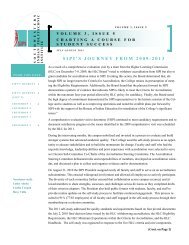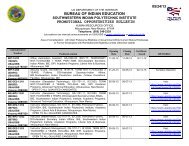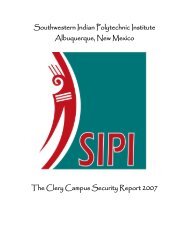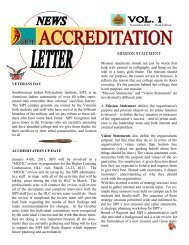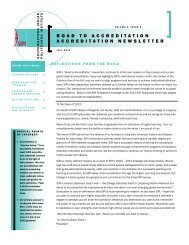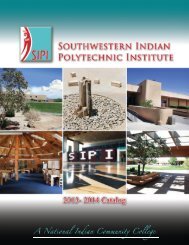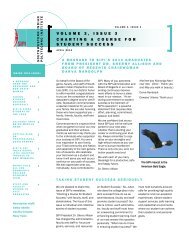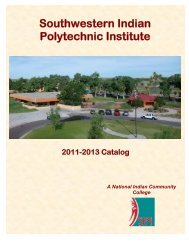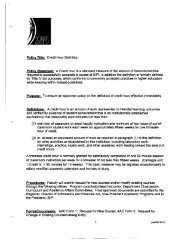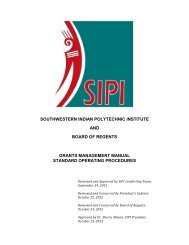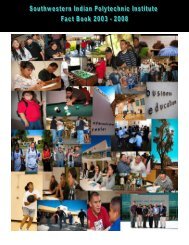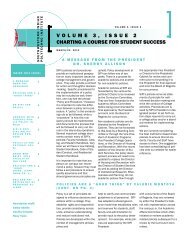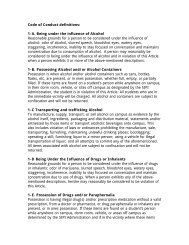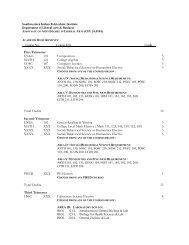volume 3, issue 1 accreditation newsletter - Southwestern Indian ...
volume 3, issue 1 accreditation newsletter - Southwestern Indian ...
volume 3, issue 1 accreditation newsletter - Southwestern Indian ...
You also want an ePaper? Increase the reach of your titles
YUMPU automatically turns print PDFs into web optimized ePapers that Google loves.
VOLUME 3, ISSUE 1<br />
Page 2<br />
THE STUDENT SUCCESS IMPERATIVE (CONT. FROM PG. 1)<br />
for managing courses and<br />
communications. Human<br />
Resources maintains processes<br />
to ensure that qualified<br />
faculty and support staff<br />
are here to help students<br />
learn. Every department in<br />
the institution ultimately contributes<br />
directly to student<br />
success, or helps create an<br />
environment that enables<br />
students to succeed. In short,<br />
we’re all in this together.<br />
SIPI has in place actions to<br />
ensure continuous improvement<br />
of student learning and<br />
processes. A central <strong>issue</strong> in<br />
the continuous improvement<br />
process is that departments<br />
identify how “what they do”<br />
contributes to this environment<br />
for student success.<br />
SIPI also has in place processes<br />
for systematic review<br />
of program and department<br />
performance to ensure longterm<br />
sustainability. At the<br />
heart of this process is the<br />
expectation that departments<br />
clearly define how they are<br />
contributing to student success.<br />
SIPI also has a strategic<br />
planning process, that requires<br />
departments and committees<br />
to develop initiatives<br />
that support the institution’s<br />
mission and vision. There are<br />
two major requirements for<br />
developing strategic initiatives:<br />
1) they are truly strategic<br />
in nature (they have a<br />
lasting, or enduring impact<br />
on the institution), and 2)<br />
they can be clearly viewed<br />
through a prism of student<br />
success (in other words, we<br />
can see how they will ultimately<br />
enable students to<br />
succeed).<br />
In the most recent version of<br />
the Higher Learning Commission’s<br />
(HLC) criteria for <strong>accreditation</strong>,<br />
a new section<br />
has been added, which requires<br />
us to explore various<br />
measures of student success.<br />
The following is the new<br />
component:<br />
4C. The institution demonstrates<br />
a commitment to<br />
educational improvement<br />
through ongoing attention to<br />
retention, persistence, and<br />
completion rates in its degree<br />
and certificate programs.<br />
1.The institution has defined<br />
goals for student retention,<br />
persistence, and completion<br />
that are ambitious but attainable<br />
and appropriate to its<br />
mission, student populations,<br />
and educational offerings.<br />
2.The institution collects and<br />
analyzes information on student<br />
retention, persistence,<br />
and completion of its programs.<br />
3.The institution uses information<br />
on student retention,<br />
persistence, and completion<br />
of programs to make improvements<br />
as warranted by<br />
the data.<br />
4.The institution’s processes<br />
and methodologies for collecting<br />
and analyzing information<br />
on student retention,<br />
persistence, and completion<br />
of programs reflect good<br />
practice. (Institutions are not<br />
required to use IPEDS definitions<br />
in their determination of<br />
persistence or completion<br />
rates. Institutions are encouraged<br />
to choose measures<br />
that are suitable to their student<br />
populations, but institutions<br />
are accountable for the<br />
validity of their measures.)<br />
Why did the HLC add this new<br />
component? At a recent<br />
workshop on the HLC’s expectations,<br />
they indicated<br />
that the purpose of this new<br />
component was to ensure<br />
that schools were having<br />
broad discussions of student<br />
success. How has this impacted<br />
SIPI? This expectation<br />
was the starting point for the<br />
Retention Committee to evaluate<br />
measures (based on<br />
historical data), set measurable<br />
goals (based on SIPI’s<br />
positions in the National<br />
Community College Benchmark<br />
Project), and augment<br />
tracking data with data on<br />
student motivations for success<br />
to develop data-driven<br />
success initiatives. These<br />
initiatives are still a work in<br />
progress, but the wheels are<br />
moving. An example of how<br />
SIPI is approaching this requirement<br />
is in persistence.<br />
Given the low persistence<br />
rates of SIPI students, the<br />
Research Office surveyed<br />
non-returning students to<br />
find out what factors kept<br />
them from returning to college.<br />
Students provided a<br />
variety of reasons for not<br />
returning, but those reasons<br />
appeared in patterns. By<br />
analyzing the data, four segments<br />
of non-returners were<br />
identified:<br />
Accomplished (37%)<br />
Completed desired courses<br />
Transferred to 4-year institution<br />
Transferred to 2-year institution<br />
SIPI lost <strong>accreditation</strong><br />
Other<br />
Disenfranchised (28%)<br />
Couldn’t get needed courses<br />
Couldn’t get courses at needed<br />
times<br />
Didn’t like instructor or instructional<br />
methods<br />
Was doing poorly in classes<br />
Had unpleasant experience<br />
Blocked from enrolling<br />
(Cont. on pg. 3)<br />
Audrey Gachupin’s family and<br />
Glennoah Billie, SIPI’s New<br />
Mexico All State Academicians<br />
“Student success is a measure<br />
of the support that a<br />
student receives. Faculty,<br />
staff, and fellow students all<br />
contribute to the success of<br />
the individual.” Randall<br />
Sahmie, Student Business<br />
Administration and Accounting<br />
Student success to<br />
me means that all<br />
Native American<br />
students within the<br />
United States are<br />
given the opportunity<br />
to achieve academic<br />
success in a safe,<br />
clean, living and<br />
learning environment.<br />
SIPI offers<br />
affordability where<br />
students can<br />
successfully complete<br />
their education goals<br />
and be prepared to<br />
continue onto a four<br />
year university.” Irene<br />
Shaw, Staff,<br />
Residential Life<br />
“Student success—when<br />
a student initially enrolls<br />
here at SIPI, is in the<br />
Adult Basic Education<br />
program, progresses onto<br />
a certificate or degree<br />
program, and graduates.<br />
This student then goes on<br />
to attend a four year university<br />
or gain employment<br />
in his/her field of<br />
study. This student has<br />
succeeded in accomplishing<br />
the goals he/she<br />
set!” Barbara Chino,<br />
Staff, Admissions


